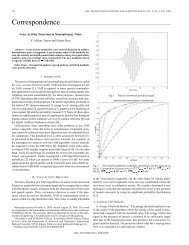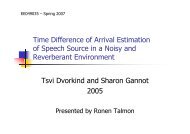Thesis (PDF) - Signal & Image Processing Lab
Thesis (PDF) - Signal & Image Processing Lab
Thesis (PDF) - Signal & Image Processing Lab
You also want an ePaper? Increase the reach of your titles
YUMPU automatically turns print PDFs into web optimized ePapers that Google loves.
94 CHAPTER 6. EXTREMA-WATERSHED TREE EXAMPLE<br />
tree and shape tree on the corrupted image shown in Fig. 6.20. A difference between<br />
the two approaches is shown in Fig. 6.21. It is interesting that there is a major<br />
difference in the erosion result, but almost no difference in the opening result. This<br />
is because in the erosion picture of the extrema watershed tree trenches are revealed.<br />
The trenches in extrema watershed tree exposes flat zones located deep into the tree.<br />
There is no similar effect in a shape tree because its tree structure is different.<br />
Note that noise connected to the image border is not filtered in the Tree of shapes<br />
and is filtered in the EWT tree. Noise is left by the shape tree filter because its<br />
“fillhole” operator does not consider this boundary noise as a hole that can be filled<br />
during tree creation process.<br />
6.3.3 Filtering using Extrema watershed tree versus tradi-<br />
tional morphological filtering<br />
In this section, filtering results using the EWT are compared with traditional erosion,<br />
dilation, opening, closing, open-close, close-open operators and median filter in a<br />
complete lattice of gray level functions. In Figs. 6.24 and 6.24, results of conventional<br />
morphological filters (erosion, dilation, opening, closing) are shown. As expected,<br />
their results are not symmetric with respect to a gray and dark pixels. Because of<br />
that, those filters cannot be compared with the extrema-watershed tree.<br />
An additional morphological filter that has a pseudo symmetrical effect is a com-<br />
bined open-close or close-open filters as described in Chapter 8 of [3]. Their results<br />
are shown in Fig. 6.26. In Fig. 6.27 a median filter result is shown and compared to<br />
the EWT result. Those two figures enable a comparison between the proposed filter<br />
and traditional approaches. It can be seen the the EWT filtered result is in general<br />
similar to an open-close and close-open results, but without a bias towards dark pixels<br />
as a close-open or towards a light pixels as an open-close filter. The median filter<br />
is unbiased, but a number of noisy pixels have survived the filtering by it, and the<br />
median filter lacks other important features. For example it is not an idempotent<br />
filter.
















